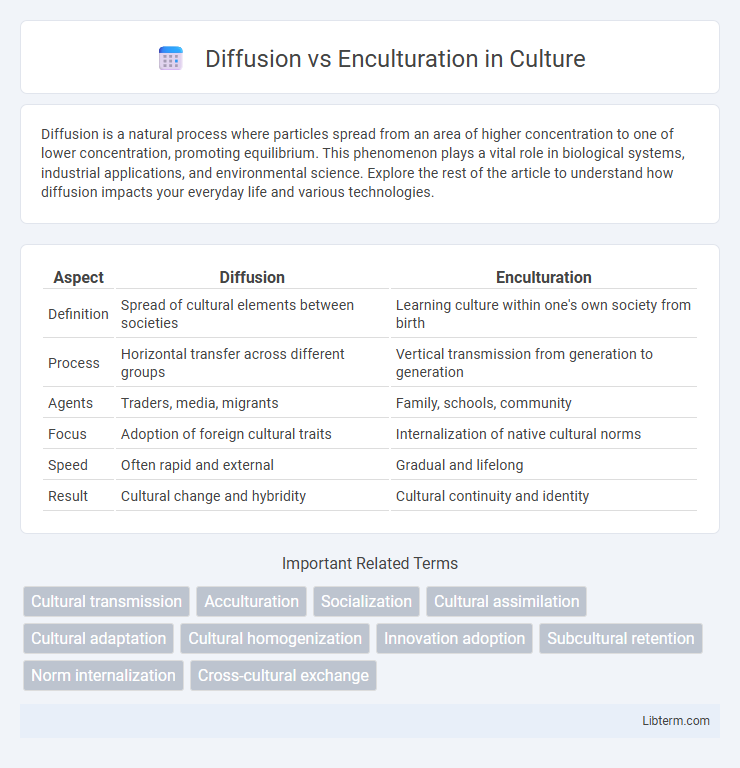Diffusion is a natural process where particles spread from an area of higher concentration to one of lower concentration, promoting equilibrium. This phenomenon plays a vital role in biological systems, industrial applications, and environmental science. Explore the rest of the article to understand how diffusion impacts your everyday life and various technologies.
Table of Comparison
| Aspect | Diffusion | Enculturation |
|---|---|---|
| Definition | Spread of cultural elements between societies | Learning culture within one's own society from birth |
| Process | Horizontal transfer across different groups | Vertical transmission from generation to generation |
| Agents | Traders, media, migrants | Family, schools, community |
| Focus | Adoption of foreign cultural traits | Internalization of native cultural norms |
| Speed | Often rapid and external | Gradual and lifelong |
| Result | Cultural change and hybridity | Cultural continuity and identity |
Introduction to Diffusion and Enculturation
Diffusion refers to the process by which cultural traits, ideas, or technologies spread from one society or group to another, facilitating the exchange and adoption of innovations across different communities. Enculturation is the lifelong process through which individuals learn and internalize the norms, values, customs, and behaviors of their own culture, shaping their identity and social practices. Both concepts explain cultural transmission but differ in that diffusion emphasizes cross-cultural exchange, while enculturation focuses on the internalization within a specific cultural context.
Defining Diffusion: Key Concepts
Diffusion is the process through which cultural elements, such as ideas, styles, religions, technologies, and languages, spread from one society or group to another, leading to cultural change. It contrasts with enculturation, which involves the internal transmission of culture within a group from one generation to the next. Key concepts in diffusion include the identification of source and recipient cultures, modes of transmission such as direct contact or indirect means, and factors influencing the rate and extent of diffusion like geographical distance, social networks, and technological advancements.
Understanding Enculturation: Core Principles
Enculturation is the lifelong process through which individuals internalize the values, norms, and customs of their culture, primarily learned within family and social groups. It involves direct teaching and observation, enabling people to function effectively within their society by adopting shared beliefs and behaviors. Unlike diffusion, which spreads cultural traits across communities, enculturation is rooted in the individual's gradual adaptation and socialization to their native culture.
Differences Between Diffusion and Enculturation
Diffusion involves the spread of cultural elements, such as technologies, ideas, or customs, from one society to another, often through trade, migration, or communication. Enculturation is the process by which individuals learn and internalize the values, norms, and behaviors of their own culture, primarily through family, education, and social interactions within their community. The key difference lies in diffusion being an external transmission of culture between groups, while enculturation is an internal acquisition of culture within an individual's native society.
Mechanisms of Cultural Diffusion
Mechanisms of cultural diffusion include migration, trade, communication, and media, which facilitate the spread of ideas, customs, and technologies across societies. Diffusion occurs when cultural elements are adopted through direct contact or indirect influence, leading to cultural change without requiring long-term social integration, unlike enculturation which involves internalizing culture from birth. These diffusion processes enable rapid cultural exchange and adaptation across diverse populations.
Processes Involved in Enculturation
Enculturation involves direct processes such as observation, imitation, and participation, enabling individuals to internalize the language, values, customs, and social norms of their culture. This process is continuous and primarily occurs through family interactions, educational systems, and peer group dynamics. Diffusion, by contrast, refers to the spread of cultural elements from one society to another, often bypassing the deep, immersive learning characteristic of enculturation.
Examples of Diffusion in Society
Diffusion in society occurs when cultural elements such as technologies, ideas, or customs spread from one group to another, evident in the global adoption of smartphones originating from South Korea and the widespread influence of American fast food chains like McDonald's. Another example includes the transmission of musical styles, such as reggae music from Jamaica gaining popularity worldwide. These instances illustrate how diffusion facilitates cultural exchange and innovation across diverse populations.
Real-World Enculturation Scenarios
Real-world enculturation scenarios emphasize the gradual acquisition of cultural norms and values through direct social interactions within family, school, and community settings. Unlike diffusion, which involves the spread of cultural elements across societies, enculturation is deeply embedded in everyday practices, shaping identity and behavior from infancy through adulthood. This process ensures the transmission of language, customs, and traditions, fostering social cohesion and cultural continuity.
Impact of Diffusion and Enculturation on Culture
Diffusion accelerates cultural change by spreading ideas, technologies, and practices across societies, fostering innovation and diversity within cultures. Enculturation ensures cultural continuity by transmitting values, beliefs, and customs from one generation to the next, reinforcing social cohesion and identity. Together, diffusion and enculturation dynamically shape cultural evolution, balancing adaptation with preservation.
Conclusion: Significance of Diffusion vs Enculturation
Diffusion and enculturation play crucial roles in the transmission of culture, with diffusion emphasizing the spread of cultural traits between societies and enculturation focusing on the internalization of cultural norms within an individual from birth. Understanding the significance of diffusion highlights how cultural exchanges drive innovation and social change across geographic boundaries. Enculturation's importance lies in maintaining cultural continuity and identity by embedding shared values and practices in successive generations.
Diffusion Infographic

 libterm.com
libterm.com